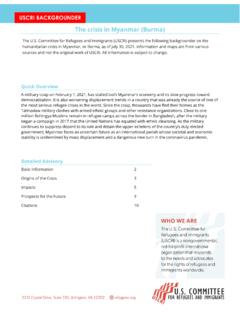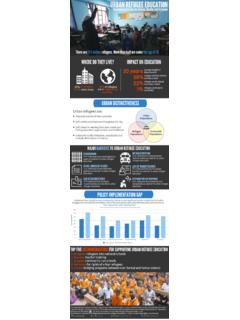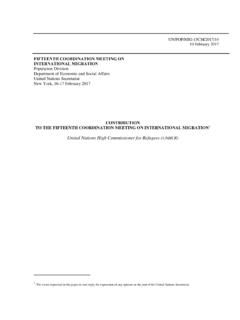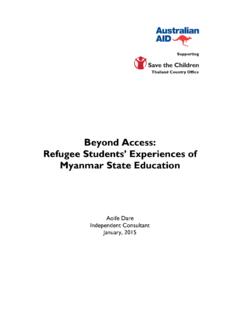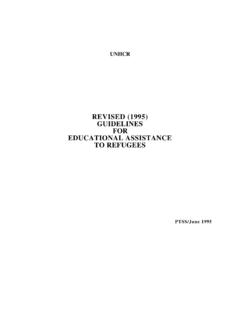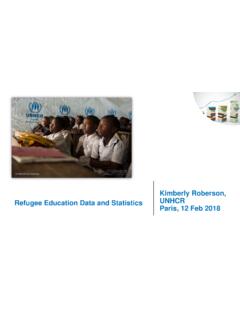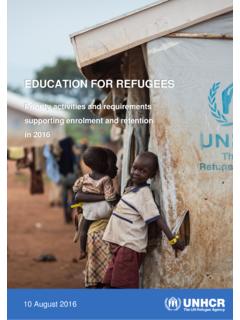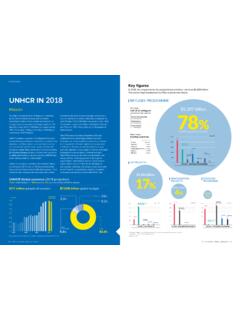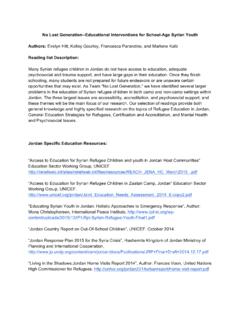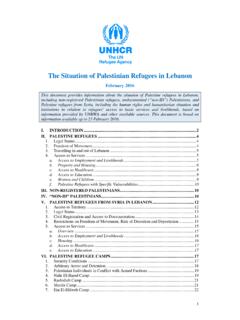Transcription of ERITREAN CHILDREN IN NORTHERN ETHIOPIA
1 FORGOTTEN REFUGEES: ERITREAN CHILDREN IN NORTHERN ETHIOPIADECEMBER 2015 FINDINGS & RECOMMENDATIONSOVERVIEW1 BACKGROUND2 OBSERVATIONS6 MISSION ACTIVITIES10 RECOMMENDATIONS11 ACKNOWLEDGEMENTS15 ENDNOTES15 TABLE OF CONTENTSF orgotten Refugees / Committee for Refugees and Immigrants 1 SCOPE OF MISSIONUSCRI has a long history nearly four decades of working with Eritreans fleeing violence and persecution. Several of our board members visited Eritrea in 1997 and visited its neighboring country ETHIOPIA in 2010. USCRI undertook its most recent mission to ETHIOPIA with the America Team for Displaced Eritreans, a Pennsylvania-based NGO, as well as other NGOs and volunteers during the first two weeks of December 2015.
2 The trip served as an essential fact-finding mission as USCRI contemplates how to provide assistance to unaccompanied CHILDREN in three refugee camps in NORTHERN ETHIOPIA . The delegation visited the region and collected up-to-date information about ERITREAN unaccompanied refugee CHILDREN temporarily residing at and registered with the Endabaguna Screening and Reception Center and those CHILDREN living in the Adi-Harush, Hitsats, and Mai-Aini camps (the Shire refugee camps ).1 2 In addition, the delegation met with officials from the United Nations High Commissioner for Refugees in ETHIOPIA ( UNHCRE thiopia ), various NGOs, and the Ethiopian government ( GoE ). This report details the delegation s findings and presents USCRI s recommendations to stakeholders.
3 PRINCIPAL FINDINGSS econdary migration is pervasive among the predominately young and urban ERITREAN refugees who initially seek protection in Shire. These refugees find that it is impossible to live comfortably and with hope for the future in the Shire camps due to the poor conditions within the camps. The refugee youth face a daily reality of limited water, food, sanitation, education, security, and opportunity. Within the Shire camps, there is little to no electric power. Eight to ten refugees collectively live in 10ft x 10ft concrete or mud dwellings in an extremely hot and arid area. Others live in tents. Within these crowded shelters, refugees must prepare their meals and store their meager rations and OVERVIEWThe delegation was concerned about the lack of basic protection for the residents of the camps that it observed.
4 Women and CHILDREN are at great risk of experiencing abduction, violence, and sexual assault when they leave the camps to collect firewood, which is needed for cooking. Because resources like firewood are very scarce in the Shire region, refugees and members of the host communities must compete for these resources. This competition occasionally becomes violent. In addition, the supervision of and care for unaccompanied CHILDREN are highly informal and inadequate. Most CHILDREN receive no formal custody arrangement in the camps. Rather, several CHILDREN are typically grouped into a shelter, and each group is paired with an unrelated adult refugee who lives nearby. For these groups, the adult neighbor serves as the CHILDREN s general point of contact within the camp.
5 In theory, these adults look after the CHILDREN and provide guidance. CHILDREN frequently report, however, that these neighbors take little interest in their well-being. Even when well intentioned, the assigned neighbors are often so desperate for their own survival and durable solutions that they leave the camps without making arrangements for other adults to care for the CHILDREN , newly arrived to theEndabaguna Screening and Reception Center,watching a video about human Refugees / Committee for Refugees and Immigrants 2II. BACKGROUNDREFUGEES IN ETHIOPIAE thiopia, a country in the Horn of Africa (northeast region), shares a border with six countries: Djibouti, Eritrea, Kenya, Somalia, South Sudan, and ETHIOPIA is comprised of nine regions including Tigray, which is the NORTHERN most region and borders Eritrea and Sudan.
6 Currently, there are 23 refugee camps in ETHIOPIA , four of which are located in Shire, a district within the Tigray The Endabaguna Screening and Reception Center and three of the four Shire refugee camps Mai-Aini, Adi-Harush, and Hitsats are the focus of this report. USCRI visited the fourth refugee camp in Shire Shimelba during its 2010 maintains an open-door asylum policy and is home to the largest refugee population in An estimated 733,644 refugees have fled to ETHIOPIA ; percent of these refugees are Within the refugee population, there are 39,273 unaccompanied or separated The majority of refugees fleeing to ETHIOPIA are from Eritrea, Sudan, South Sudan, and is the largest producer of refugees in Africa.
7 According to the United Nations High Commissioner for Refugees ( UNHCR ), an estimated 5,000 people,9 mainly urban and educated youth, leave the country every month. And, since 2004, more than 112,00010 ERITREAN refugees have requested asylum and protection in ETHIOPIA . These ERITREAN refugees are fleeing human rights violations, as detailed in the United Nations Human Rights Council s 2015 report on human rights violations in These abuses Refugee youth flee the camps on a daily basis, and the whereabouts of thousands of these CHILDREN are unknown. The pertinent question is not why are these CHILDREN leaving? It is why would a child stay in these camps indefinitely? The most common phrase our delegation heard was these CHILDREN have lost hope.
8 Include mass surveillance and forced labor through open-ended national service as well as repression of the freedoms of movement, assembly, expression, press, and In addition, Eritreans frequently disappear and are routinely and arbitrarily arrested, detained, tortured, or executed without due process. In 1968, during an earlier period of mass refugee migration, more than 150,000 ERITREAN refugees fled to Sudan due to Eritrea s war of independence. This war sparked the longest-standing refugee crisis in and its partners visited the Endabaguna Reception Center and three refugee camps in the Shire district of addition to gaps in shelter provision, there are substantial gaps relating to food and water rations, security, and education.
9 Two of the camps visited have no secondary school or recreation facilities for teens. Moreover, the regional reception center does not have a primary or secondary school despite the fact that some CHILDREN stay there for two months waiting for a shelter in the Refugees / Committee for Refugees and Immigrants 3 The Government of ETHIOPIA (GoE) manages all refugee camps through the Administration for Refugee and Returnee Affairs (ARRA).13 ARRA, UNHCR, and a network of civil society partners work jointly to protect and assist Although there has been an influx of ERITREAN refugees into Shire, the refugee population in the camps tends to remain around 30,000 This is because approximately 75 percent of ERITREAN refugees (over 80,000 people to date) have engaged in secondary While many have traveled to Europe or Israel via Sudan, refugees are also living in ETHIOPIA s urban areas such as Addis is party to the 1951 Convention Relating to the Status of Refugees and its 1967 Protocol, although ETHIOPIA has maintained reservations relating to refugees right to work.
10 It is also party to the 1969 OAU Convention Governing the Specific Aspects of Refugee Problems in Africa, which includes in the definition of refugee those fleeing war and generalized ETHIOPIA s 2004 Refugee Proclamation established a procedure for applying for asylum and incorporated the conventions refugee definitions. The Proclamation prohibited the GoE from refusing entry to refugees and from returning them to any country where they would be at risk of persecution. This mandate also granted refugees some of the rights outlined in the inter-governmental conventions but denied refugees rights to movement and work. However, the country supports an out-of-camp program, solely for ERITREAN refugees, which allows [ ERITREAN ] refugees to live outside of camps and engage in informal livelihood opportunities.
